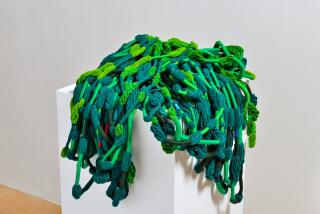Quilt Exhibit Covers Boon and Bane of Mechanization
Homemade quilts took a role in American domestic life as soon as there were fabric scraps and women to sew them. People interested in grass-roots aesthetic expression came to value quilts as folk art.
In the 1970s, feminists celebrated them as undervalued evidence of women’s creativity. Abstract painters chimed in because quilts’ indigenous authenticity made such refined styles as color stain painting appear less esoteric.
Appreciation promoted quilting to a place in the decorative arts departments of art museums. Now the Gene Autry Museum of Western Heritage offers “Patterns of Progress: Quilts in the Machine Age.”
Assembled by guest curator Barbara Brackman, the show does important things. Tracing the impact of the household sewing machine, it suggests the industrial revolution had some positive effect on the lives of Western women. (The show doesn’t deal with the sweat-shop mill towns of New England.)
It opens with examples of hand-sewn vintage quilts, display cases of quaint early sewing machines and slightly surreal photographs. One captures a women seated at her Singer in the middle of a dusty nowhere. Archaic machines required cranking with one hand, making it tough to feed fabric. All the same, it appears that mechanization was a boon. It even made new quilt genres now considered traditional--such as the crazy quilt--technically possible.
Before the turn of the century, sewing well was so crucial to women’s lives that little girls were taught to stitch before they learned to read or write. Being an inept seamstress severely hampered marital prospects. Women sewed for their families and took in work to earn important extra cash.
Hand sewing, in short, was drudgery. Sewing machines whizzed right along. Even the women of Native American tribes liked them. For pioneer females with a taste for singularity, owning a good sewing machine could lead to independence. By 1900, a woman’s conversational adroitness was deemed more important than sewing a fine seam.
Given all that, it seems almost silly to worry about the machine’s effect on the aesthetics of quilting. The exhibition does demonstrate that mechanization caused degradation in ornamental hand sewing. But the same mechanization created leisure time. That gave quilt-makers the opportunity to make aesthetic choices about their methods.
Most of the exhibition is devoted to a display of 66 quilts made mainly since the arrival of the sewing machine. An anonymous “Star Medallion” quilt from before 1850 is all hand-made. A “Bullet/Rin Tin Tin” design from 1950-65 is equally hand-crafted. It’s a wonderful tour-de-force of 64 panels depicting dogs in action. Each is lovingly embroidered like a line drawing in thread. It calls attention to the unknown maker’s decision to do this the hard way.
By contrast, Ernest B. Haight’s circa-1970 “Falling Blocks” was made entirely with an electric sewing machine. Haight, a relatively rare male quilt artist, was trained as an agricultural engineer and worked as a Nebraska farmer. He started quilting on a bet with his wife. He became a pioneer of the fast, pure-machine quilt. “Falling Blocks” is a witty, sophisticated optical illusion.
San Francisco’s Joe Cunningham is the exhibition’s only other male quilter. The title of his “This Is a Quilt, Not Art” poses what--on present evidence--is the contemporary quilt-makers central dilemma. It isn’t mechanical, it’s the old question of what you do with complete freedom.
Having received a certain permission from the fine arts to innovate, quilt artists struggle to find the appropriate parameters of their medium. Viewed in a gallery setting, quilting seems to have a lot in common with painting. There are crucial differences. Quilting is another tradition. Quilts aren’t painted, they’re pieced together from fabric. They’re most often intended for beds, not walls.
Sandi Fox is a leading L.A. quilt artist and a key figure in raising local consciousness about the form. Her quilt, “The People/The Place” is done by hand and respects traditional symmetry. By subtle adjustment of color and placement, however, she gains an optical force associated with painting while retaining the textural warmth of cloth.
Houston’s Libby Lehman pushes toward a kind of New Age-psychedelic color and pattern. In “Aftershocks,” she makes it work; in “Joy Ride,” she doesn’t. The difference is that in the latter, an image that wants to be as transparent as electricity is bogged down by our realization that it’s all made of textured cloth.
* Gene Autry Museum of Western Heritage, 4700 Western Heritage Way, Griffith Park, through Jan. 25, closed Mondays, (213) 667-2000.
More to Read
The biggest entertainment stories
Get our big stories about Hollywood, film, television, music, arts, culture and more right in your inbox as soon as they publish.
You may occasionally receive promotional content from the Los Angeles Times.










